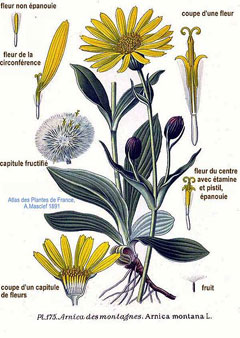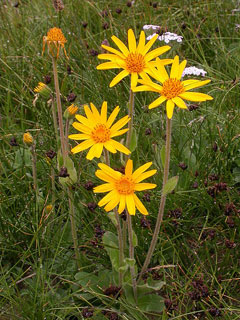 |
|
http://commons.wikimedia.org/wiki/File:175_Arnica_montana_L.jpg |
 |
| http://commons.wikimedia.org/wiki/File:Arnica_montana.JPG |
Translate this page:
Summary
Physical Characteristics

 Arnica montana is a PERENNIAL growing to 0.3 m (1ft) by 0.2 m (0ft 8in).
Arnica montana is a PERENNIAL growing to 0.3 m (1ft) by 0.2 m (0ft 8in).
See above for USDA hardiness. It is hardy to UK zone 6 and is not frost tender. It is in flower in July. The species is hermaphrodite (has both male and female organs) and is pollinated by Bees, flies, Lepidoptera (Moths & Butterflies). The plant is self-fertile.
Suitable for: light (sandy), medium (loamy) and heavy (clay) soils, prefers well-drained soil and can grow in nutritionally poor soil. Suitable pH: mildly acid, neutral and basic (mildly alkaline) soils and can grow in very acid soils.
It can grow in semi-shade (light woodland) or no shade. It prefers moist soil.
UK Hardiness Map
US Hardiness Map
Synonyms
Arnica montana var. alpina L. Arnica montana var. angustifolia
Plant Habitats
Woodland Garden Sunny Edge; Dappled Shade; Cultivated Beds;
Edible Uses
References More on Edible Uses
Medicinal Uses
Plants For A Future can not take any responsibility for any adverse effects from the use of plants. Always seek advice from a professional before using a plant medicinally.
Antiecchymotic Antiphlogistic Antirheumatic Epilepsy Nervine Sternutatory Vulnerary
Arnica has a long history of herbal use, especially as an external treatment for bruises and sprains[232, 238] - it is an ingredient of a number of proprietary preparations[238]. Internally, it has been used in the treatment of heart complaints and as a booster for the immune system[238]. Arnica increases local blood supply and accelerates healing, it is anti-inflammatory and increases the rate of absorption of internal bleeding[254]. Generally the plant is nowadays only recommended for internal use as a homeopathic medicine, principally for treating shock, injury and pain[254]. If used as a decoction or tincture it stimulates the circulation and is valuable in the treatment of angina and a weak or failing heart, but it can be toxic even at quite low doses and so is rarely used this way[254]. The flowers are the part most commonly used[4, 232], they are harvested when fully open and dried - the receptacles are sometimes removed since these are liable to be attacked by insects[4]. The root is also used, it is harvested after the leaves have died down in the autumn and dried for later use[4]. The whole plant is antiecchymotic, antiphlogistic, nervine, sternutatory, vulnerary[4, 7, 9, 46, 165]. Although a very valuable remedy, it should be used with caution. It has been known to cause contact dermatitis when used externally and collapse when taken internally[238]. Only take it internally under the supervision of a qualified practitioner. The freshly crushed flowers cause sneezing if inhaled[232]. The leaves have also been smoked as a tobacco[232], though it is unclear whether this was for medicinal reasons The whole plant, harvested when in flower, is used in homeopathic remedies[232]. It is especially useful in the treatment of traumatic injuries, sores and bruises[232]. The homeopathic dose has also been used effectively in the treatment of epilepsy and seasickness, and it might be of use as a hair growth stimulant[268]. The German Commission E Monographs, a therapeutic guide to herbal medicine, approve Arnica montana for fever and colds, inflammation of the skin, cough/bronchitis, inflammation of the mouth and pharynx, rheumatism, common cold, blunt injuries, tendency to infection (see [302] for critics of commission E). The essential oil has to be diluted before being used externally [301].
References More on Medicinal Uses
The Bookshop: Edible Plant Books
Our Latest books on Perennial Plants For Food Forests and Permaculture Gardens in paperback or digital formats.

Edible Tropical Plants
Food Forest Plants for Hotter Conditions: 250+ Plants For Tropical Food Forests & Permaculture Gardens.
More

Edible Temperate Plants
Plants for Your Food Forest: 500 Plants for Temperate Food Forests & Permaculture Gardens.
More

More Books
PFAF have eight books available in paperback and digital formats. Browse the shop for more information.
Shop Now
Other Uses
References More on Other Uses
Cultivation details
Prefers a moist, well-drained humus rich soil, preferably lime-free[200]. One report says that it is often found in calcareous soils in the wild[7]. Tolerates a pH in the range 5.8 to 7.6. Prefers a mixture of sand, loam and peat[1]. Prefers a position in full sun[1, 134]. Succeeds in light woodland[14] and in a rock garden or border[1, 14]. Plants are hardy to about -25°c[187]. This species is declining in the wild, probably because of over-collection as a medicinal herb. It may become extinct in part of its range[200].
References Carbon Farming Information and Carbon Sequestration Information
Temperature Converter
Type a value in the Celsius field to convert the value to Fahrenheit:
Fahrenheit:
The PFAF Bookshop
Plants For A Future have a number of books available in paperback and digital form. Book titles include Edible Plants, Edible Perennials, Edible Trees,Edible Shrubs, Woodland Gardening, and Temperate Food Forest Plants. Our new book is Food Forest Plants For Hotter Conditions (Tropical and Sub-Tropical).
Shop Now
Plant Propagation
Seed - best sown as soon as it is ripe in pots outdoors. Sow stored seed in early spring in a cold frame[4]. A period of cold stratification is helpful[238]. The fresh seed can germinate in 3 - 4 weeks at 13°c according to one report[134], though it can be slow, difficult and erratic and take 2 years to germinate[268]. Prick out the seedlings into individual pots when they are large enough to handle and plant them out into their permanent positions in the following spring. Division in spring.
Other Names
If available other names are mentioned here
Native Range
EUROPE: Denmark, Norway, Sweden, Austria, Belgium, Switzerland, Czech Republic, Germany, Hungary (extinct?), Netherlands, Poland, Belarus, Lithuania (extinct?), Ukraine, Bulgaria, Bosnia and Herzegovina, Croatia, Italy, Montenegro, Romania, Slovenia, Spain, France, Portugal
Weed Potential
Right plant wrong place. We are currently updating this section.
Please note that a plant may be invasive in one area but may not in your area so it's worth checking.
Conservation Status
IUCN Red List of Threatened Plants Status :

Growth: S = slow M = medium F = fast. Soil: L = light (sandy) M = medium H = heavy (clay). pH: A = acid N = neutral B = basic (alkaline). Shade: F = full shade S = semi-shade N = no shade. Moisture: D = dry M = Moist We = wet Wa = water.
Now available:
Food Forest Plants for Mediterranean Conditions
350+ Perennial Plants For Mediterranean and Drier Food Forests and Permaculture Gardens.
[Paperback and eBook]
This is the third in Plants For A Future's series of plant guides for food forests tailored to
specific climate zones. Following volumes on temperate and tropical ecosystems, this book focuses
on species suited to Mediterranean conditions—regions with hot, dry summers and cool, wet winters,
often facing the added challenge of climate change.
Read More
Expert comment
Author
L.
Botanical References
200
Links / References
For a list of references used on this page please go here
Readers comment